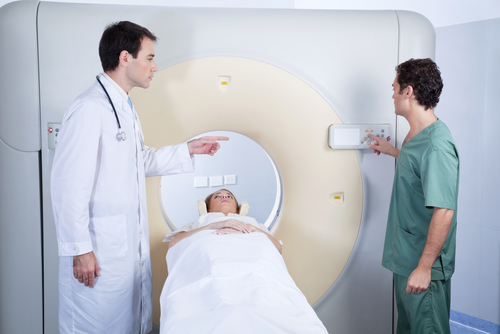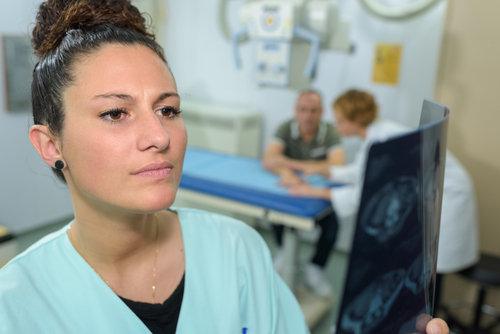
Do you enjoy working with technical equipment? You can have the satisfaction and high earning potential of a healthcare career without spending years in medical school. A career as a radiologic technologist could be the perfect choice for you.
Radiologic technologists perform diagnostic imaging examinations, like X-rays and computed tomography (CT) scans. These professionals work in hospitals, doctors’ offices, laboratories and outpatient facilities. They interact directly with patients, run imaging equipment. They work with doctors to interpret test results. Though higher education is necessary for this position, you can begin your career with a certificate or associate’s degree. Use these tips to find the best degree path for becoming a radiologic technologist major.
A Radiography Education
For aspiring radiologic technologists, a postsecondary education is essential. The Joint Review Committee on Education in Radiologic Technology (JRCERT) accredits radiography education programs at the associate’s and bachelor’s degree levels. They also accredit programs that culminate in a graduate certificate. At any education level, you should expect to spend time studying:
- anatomy
- radiation physics
- pathology
- patient care
- image evaluation
In addition to learning course material in the classroom, you will also go through clinical training to acquire some real-world experience before you graduate.
Most radiologic technologists start their careers with an associate’s degree program according to the United States Bureau of Labor Statistics (BLS). However, a bachelor’s degree can help you stand out and give you a competitive edge when seeking the most desirable radiologic technologist positions. Radiography programs at the bachelor’s degree level go into greater detail and provide a more in-depth background associate’s degree programs. A bachelor’s degree in radiography can also prepare you for medical school, if you decide to become a type of doctor called a radiologist.
Generally, professionals with bachelor’s degrees earn $2.4 million over their working lives compared to just $1.8 million for those with an associate’s degree.
So choosing which level of degree to pursue is a major decision.
Other Requirements for Radiologic Technologists
In some states, education is only one part of preparation for a career as a radiologic technologist. These states require candidates to hold a certification or license to work as a radiologic technologist. Typically, candidates must earn a passing score on a state examination or the American Registry of Radiologic Technologists (ARRT)’s certification test.
There are plenty of reasons to pursue a career in radiography. Radiologic technicians can look forward to a 21 percent increase in job opportunities over a decade, compared to just 11 percent of growth expected for all occupations, according to the BLS. They earn a median salary of $54,620 per year, substantially higher than the $34,750 median annual salary for all occupations.
Characteristics of a Successful Radiologic Technologist

People who are thinking of a radiologic technologist major should consider their personality traits and characteristics. There are certain qualities that will help you do well in this career. Most of these characteristics are part of a personality, but it is possible to practice or hone these qualities while pursuing a radiologic technologist major.
One of the key characteristics of a strong radiologic technologist is an orientation to detail. The technologist must be able to follow the exact instructions of the physician ordering the X-rays or magnetic resonance images (MRIs). The technologist should also be able to position the patient in a way that allows the correct images to be taken by the MRI or X-ray machine.
Interpersonal skills are also essential. Many patients who need an X-ray or MRI scan are in pain. They may be stressed. Putting them at ease and helping them get as comfortable as possible makes it easier for the technician to get the right images. A person who has never had a X-ray or MRI test may be nervous. The technician should be able to explain how the machine works and what to expect. They should be able to do this in a way that calms the patient and addresses any worries or fears the patient has about the imaging studies.
Math skills are important for a successful radiologic technologist major. Some X-rays and MRI scans require the use of a contrast dye. These dyes must be mixed with the right dosage for the weight and age of the patient. Some of these dyes cause a temporary sensation of discomfort for the patient, so the technologist will need to explain this and why it is important for the dye to be used in the test.
Physical strength is necessary. You may need to move the X-ray machine to get the right view of the patient. Yoou may also need to assist the patient with getting into the correct position. For example, MRI scans require the patient to lay still on a narrow table that moves into and out of the MRI machine. The technologist may need to help the patient onto the table for the start of the procedure. They may also need to help the patient sit up and get off the table when the procedure is finished. Some patients who need an MRI or X-ray are immobile due to an injury, illness or disorder. The radiologic technologist may need to lift the patient onto and off of the table.
X-ray and MRI machines are complicated. A successful radiologic technologist major needs to have the right technical skills to operate these machines. In particular, X-ray machines can be harmful to one’s health if used improperly. The radiologic technologist must know all the correct safety procedures and follow them in order to protect the patient’s health and their own health.
Critical thinking skills are also needed for becoming a radiologic technologist. It is possible for an X-ray or MRI machine to malfunction during a scan. You should be able to follow a series of safety procedures to get the patient out of harm’s way. You also need to know how to report problems with equipment and create a detailed report of what happened during the malfunction.
Teamwork skills are needed for a radiologic technologist to do well . The technicians usually work under a radiologist. They also work with:
- patient care advocates
- social workers
- registered nurses
- emergency medicine physicians
- other healthcare professionals
They are a part of a team that provides all the necessary services to the patient.
As a successful radiologic technician need to have excellent communication skills. You should be able to communicate in words to patients of all ages about:
- the procedure
- what you will do
- what the patient needs to do
You should be able to indicate in writing any notes related to the procedure. Radiologic technicians also need to read the orders of the physician to know how to perform the test and any special procedures, images or scans that are needed for each person’s situation.
Salary Information for Radiologic Technologist Majors

As of May 2019, the median annual salary of a radiologic technologist with an MRI certification was $73,410. The lowest-paid 10% of earners had a median annual salary of $51,150, and the highest-paid 10% of earners had a median salary of $101,580. The highest-paying employers for radiologic technicians included:
- outpatient care centers, with median annual salaries of $90,820
- medical and diagnostic laboratories, with median annual salaries of $74,560
Hospitals, including those that are state, local or private, paid median annual salaries of $72,750. Physician offices paid a median annual salary of $72,400 to MRI technicians.
For X-ray technicians, the median annual salary as of May 2019 was $60,510. The lowest-paid 10% of earners had a median annual wage of $41,480. The highest-paid 10% of earners had median annual salaries of $89,760. The highest-paying industry of employment for X-ray technicians is the federal government, with a median annual salary of $65,780.
Those employed at outpatient care centers earned a median salary of $63,000. X-ray technicians who work at hospitals had a median annual salary of $61,670. Those who work at medical and diagnostic laboratories earned a median annual salary of $61,270. The X-ray technicians employed at the offices of physicians had the lowest median annual salaries, which were $55,170.
Some states and metropolitan areas have higher pay rates than others for radiologic technician majors. The top five states for earnings of MRI technicians are:
- California
- Hawaii
- Washington
- Nevada
- Alaska
The cities or metropolitan areas with the highest median annual wages for MRI technicians are:
- Vallejo/Fairfield, CA, at $124,950
- San Francisco/Oakland/Hayward, CA, at $104,870
- Seattle/Tacoma/Bellevue, WA, at $99,920
- Los Angeles/Long Beach/Anaheim, CA, at $99,860
- Modesto, CA, at $99,360
The top five states or administrative regions for the earnings of X-ray technicians are:
- California
- Hawaii
- District of Columbia
- Massachusetts
- Alaska
The top-paying cities or metropolitan areas for X-ray technologists include:
- Salinas
- Vallejo
- San Francisco
- Sacramento
- Redding, CA
Radiologic technicians with more than one certification can earn higher pay. Those who work third-shift may also earn more.
Job Outlook for Radiologic Technician Majors
As of 2019, there were 250,700 people employed as radiologic technologists in the United States. The number of technicians is expected to grow to 267,000 by 2029. The BLS explains that the job outlook for radiologic technologists is 7% between 2019 and 2029. This is faster than the average for all occupations tracked by the BLS. Most of this growth will be in outpatient clinics. This fast rate of job growth is due to the aging of the baby boomer generation. As they get older, they’re at an increased risk for falls, brain disorders and other conditions that require imaging for a diagnosis. Technicians who have credentials and a bachelor’s degree in nuclear medicine or medical technology will have the best job prospects.
There are a few additional factors that increase a radiologic technologist major’s chances of gaining employment. Speaking more than one language is helpful. This is because many people in need of healthcare do not speak English as their primary language. Radiologic technicians who have related certifications, such as sonography and nuclear medicine, will find that there are more job opportunities.
The states with the highest employment levels for MRI technicians are:
- California
- Florida
- Texas
- New York
- Illinois
The cities or metropolitan areas with the most jobs for MRI technicians include:
- New York City, NY
- Newark, NJ
- Chicago, IL
- Boston, MA
- Miami, FL
- Los Angeles, CA
The states with the most X-ray technician jobs are:
- California
- Florida
- Texas
- New York
- Pennsylvania
The metropolitan areas and cities with the highest employment levels of X-ray technicians are:
- New York City, NY
- Chicago, IL Los Angeles, CA
- Miami, FL
- Houston, TX
Work Environment and Hours for Radiologic Technicians

Radiologic technicians work in a fixed healthcare setting. They may need to stand in a small booth while performing the scan. For MRI technicians, this booth is sound-proof. The X-ray booths shield the technician from the X-ray radiation. Because people may be injured or develop an acute problem at any time of the day or night, radiologic technicians are present in hospitals and outpatient healthcare settings 24/7. Technicians may need to work the third shift, weekends and holidays. Many employers offer rotating schedules and have on-call hours.
Recertification Requirements for Radiologic Technicians
There are two recertification pathways for radiologic technicians. The American Registry of Radiologic Technologists (ARRT) certifies X-ray technicians. The American Registry of Magnetic Resonance Imaging Technologists (ARMRIT) certifies MRI technicians. It is possible to have both certifications, but the technologist has to earn them separately.
Once an initial certification is earned from the American Registry of Radiologic Technologists, the radiologic technician will need to get re-certified every year. In order to gain recertification, the technician has to complete biennial continuing education requirements. Those include:
- classroom activities
- online classes
- self-study modules and more
The technologist has to complete a minimum of 24 continuing education units every two years. Every 10 years, the radiologic technologist must complete ARRT’s Continuing Qualifications Requirements. This is due to the fact that radiologic technology changes at a rapid pace. What the technologist learned while earning their credentials may be a lot different from what is taught in new curricula.
For recertification through the American Registry of Magnetic Resonance Imaging Technologists, the technician must also complete at least 24 hours of continuing education units every two years. These units can be spread across different learning modes and topics. Some of the topics include:
- new technology
- ethics
- patient safety
- nuclear medicine
With enough experience, radiologic technologists can take a test to become certified to perform magnetic resonance imaging (MRI) examinations. This can increase salary potential and career opportunities. The best radiologic technologists enjoy the work itself, including interacting with patients and using diagnostic imaging equipment.
Related Resources:
